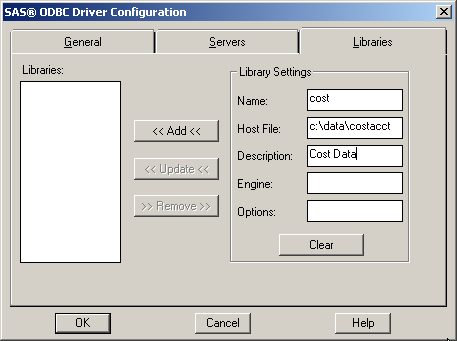Using the Libraries Tab
Purpose of the Libraries Tab
Each DSN is associated with a server, and a server can
access multiple data libraries. Therefore, you provide information
about each data library that you want to access from a server.
This tab has the following
fields:
identifies the name for an existing physical SAS library that you
want to access. (If you are familiar with SAS, this field corresponds
to the libref in the SAS LIBNAME statement.) The name can be up to
eight characters. The first character must be a letter or an underscore.
Subsequent characters can be letters, numeric digits, or underscores.
Blank spaces and special characters are not allowed. For example,
you might use the name
cost to designate
a library of cost accounting data.
identifies the pathname
of the library. For example, SAS/SHARE SAS/SHARE
c:\data\costacct d:\data \\acctsrv\customers identifies the name
of the SAS engine that is required for writing to and reading from
this library. This setting is necessary only if you do not want to
use the
V9 engine, which is
the default for SAS 9.3. For information about other engines that
might be available, see the description of the LIBNAME statement in
the SAS Companion for Windows. Providing this value is optional.
Defining Libraries at Server Start-Up Time
Server administrators
might prefer to define SAS libraries at server start-up time, rather
than defining them through the SAS ODBC Driver Configuration dialog boxes. Defining libraries at server start-up time can make
opening the data source faster. It enables you to avoid hardcoding
the physical names of your libraries in your SAS ODBC data source
definitions.
The driver communicates
with a SAS/SHARE server
(invoked by PROC SERVER) to access remote data or a SAS ODBC server
(invoked by PROC ODBCSERV) to access local data. To define a data
library at server start-up time, you precede the PROC SERVER or PROC
ODBCSERV statement with a SAS LIBNAME statement. For example, you
could define a library of cost accounting data to a SAS/SHARE server as follows:
options VALIDVARNAME=any; libname cost 'c:\data\costacct'; proc server id=acctserv authenticate=optional; run;
Note: Depending on whether the
server is running in secured mode, the
authenticate=optional option might not be needed.
To define this library
to a SAS ODBC server, you would add only the previous LIBNAME statement
to the
!SASROOT\core\sasmacro\sasodbc.sas file.
